There are many ways to cook a filet mignon, but the tried-and-true method of a reverse sear is always my choice for a thicker cut of meat like a filet mignon.

A reverse sear is an ideal way to ensure consistency of your finished cook and avoid that terrible feeling of cutting into an overcooked (and expensive) steak! As the method states, you are reversing the process, so you start by cooking your steak at a low temperature (200°F) until it is close to done. Then, it is placed on a scorching hot grill or skillet to finish.
Jump to:
Ingredients
- Filet Mignon Steaks
- Kosher salt
- Ground pepper
- Rosemary sprigs
- Olive oil
- Compound butter
See recipe card for quantities.
How to grill the perfect filet mignon
Selecting your steaks
The first and most crucial step in preparing a delicious filet mignon, is to visit a quality butcher and have them cut you the desired size. When requesting your cuts, be sure to get consistency in the width and thickness so they cook evenly.
Season the filet mignons
Season the steaks liberally, on both sides, with kosher salt (approximately 2 teaspoons per steak), and a sprinkle of freshly ground pepper. Then set aside for 15 minutes at room temperature, while you heat your grill (or oven) to 200°F.
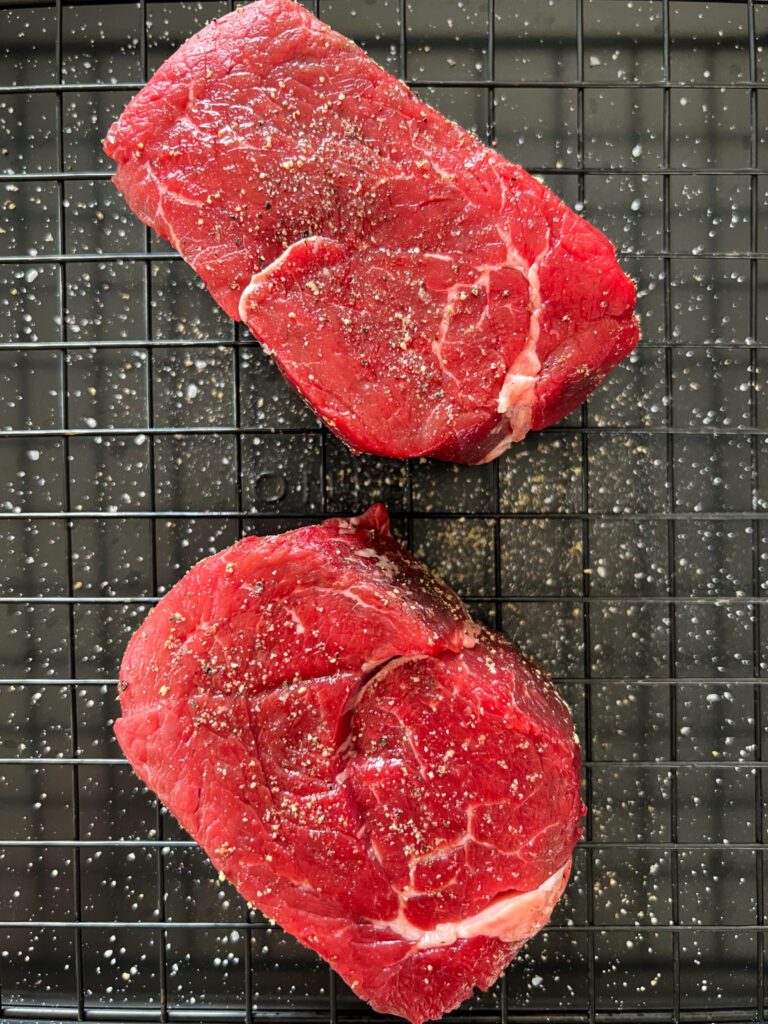
Reverse sear
A reverse sear is an ideal way to ensure consistency of your finished cook and avoid that terrible feeling of cutting into an overcooked steak.
Place a bed of rosemary inside your skillet, then place the steaks on top of the rosemary. Slowly roast the steaks until they reach an internal temperature of about 120°F, 30 to 45 minutes (depending on the thickness of the steak), flipping the steaks halfway through cooking (20-minute mark).
** These steaks were 10 ounces each and took 45 minutes. An 8-ounce steak would be closer to 30 minutes Start checking smaller steaks earlier. **
Sear the Steaks
Take the steaks from the skillet and let it rest on a board uncovered for 10 minutes. Now you have the choice to sear the steaks in the skillet or on the grill. Both will provide amazing results as long as the skillet or the grill reach a surface temperature around 600°F. Use an infrared thermometer for an accurate measurement.
Alternatively, check your grill thermometer with the lid shut for at least 5 minutes.
You can also test if the skillet is ready by pouring ½ teaspoon of water into the middle of the pan; if it completely evaporates in 5 seconds, you should be good to go.
** I seared my steaks on the grill this time, to allow me the opportunity to cook my smashed potatoes in the pan juices from the steaks and rosemary. Such a great flavour to add to potatoes** Whichever method you choose, brush a very light coat of olive oil onto both sides of the steaks.
Then sear the steak for 90 seconds per side. For the best skillet sear, use a NanoBond skillet large enough that the steaks do not touch.
Rest the steaks
Remove the steaks a board to rest for 5 minutes. This a great time to add a pad of compound butter to melt all over the steaks.
** I used a mix of fresh thyme, rosemary, garlic, salt & pepper for my butter. **
Steak temperature
These instructions will cook your steak to a lovely medium rare. If you want your steak medium, allow it to roast to an internal temperature between 125°F to 130°F. Then sear as described above.
Enjoy!
Serving suggestions
Serve the steaks whole or slice diagonally against the grain. Serve with your favourite grilled seasonal vegetables and rosemary smashed potatoes.
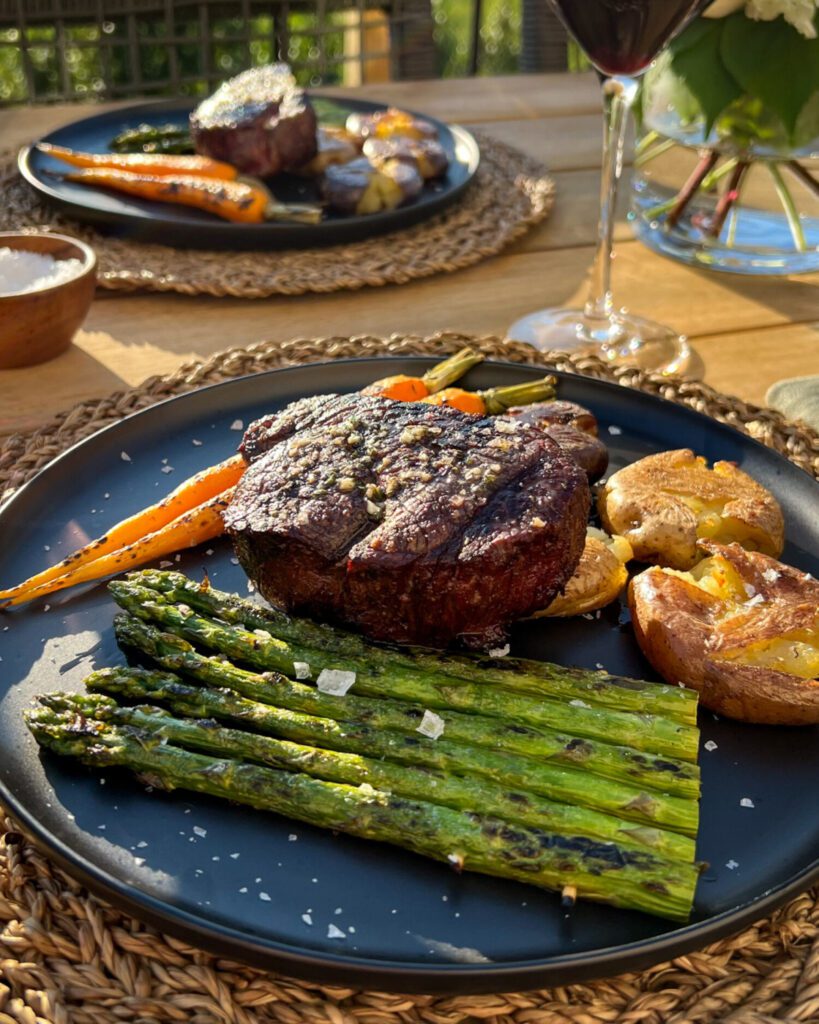
Watch the process video here
Cooked in the Hestan 11″ NanoBond Skillet on my 36″ Hestan freestanding Grill. Proud Hestan Culinary and Hestan Ambassador. Opinions in this post are my own.
Tried this recipe?
If you get the chance to try this recipe, please drop back and leave us a comment and rating. We would love to know what you think.
Cheers! James & Elaine
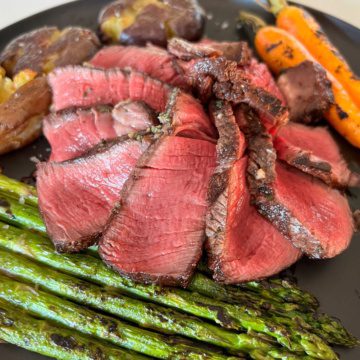
Filet Mignon (Reverse Sear)
Ingredients
- 2 – 10 ounce Filet Mignon Steaks
- 4 teaspoons Kosher salt
- freshly ground pepper
- 2 -3 sprigs of rosemary
- olive oil
- 2 pads of compound butter ** I used a mix of fresh thyme, rosemary, garlic, salt & pepper for my butter. **
Instructions
- Selecting your steaks. The first and most crucial step in preparing a delicious filet mignon, is to visit a quality butcher and have them cut you the desired size. When requesting your cuts, be sure to get consistency in the width and thickness so they cook evenly.
- Season the steaks liberally, on both sides, with kosher salt (approximately 2 teaspoons per steak), and a sprinkle of freshly ground pepper. Then set aside for 15 minutes at room temperature, while you heat your grill (or oven) to 200°F.
- A reverse sear is an ideal way to ensure consistency of your finished cook and avoid that terrible feeling of cutting into an overcooked steak.Place a bed of rosemary inside your skillet, then place the steaks on top of the rosemary. Slowly roast the steaks until they reach an internal temperature of about 120°F, 30 to 45 minutes (depending on the thickness of the steak), flipping the steaks halfway through cooking (20-minute mark).** These steaks were 10 ounces each and took 45 minutes. An 8-ounce steak would be closer to 30 minutes Start checking smaller steaks earlier. **
- Sear the Steaks. Take the steaks from the skillet and let it rest on a board uncovered for 10 minutes. Now you have the choice to sear the steaks in the skillet or on the grill. Both will provide amazing results as long as the skillet or the grill reach a surface temperature around 600°F. Use an infrared thermometer for an accurate measurement. Alternatively, check your grill thermometer with the lid shut for at least 5 minutes. You can also test if the skillet is ready by pouring ½ teaspoon of water into the middle of the pan; if it completely evaporates in 5 seconds, you should be good to go.** I seared my steaks on the grill this time, to allow me the opportunity to cook my smashed potatoes in the pan juices from the steaks and rosemary. Such a great flavour to add to potatoes** Whichever method you choose, brush a very light coat of olive oil onto both sides of the steaks. Then sear the steak for 90 seconds per side. For the best skillet sear, use a NanoBond skillet large enough that the steaks do not touch.
- Rest the steaks. Then remove them to a board to rest for 5 minutes. This a great time to add a pad of compound butter to melt all over the steaks. ** I used a mix of fresh thyme, rosemary, garlic, salt & pepper for my butter. **
- Serving suggestions. Serve the steaks whole or slice diagonally against the grain. Serve with your favourite grilled seasonal vegetables and rosemary smashed potatoes.
- Steak temperature. These instructions will cook your steak to a lovely medium rare. If you want your steak medium, allow it to roast to an internal temperature between 125°F to 130°F. Then sear as described above. Enjoy!


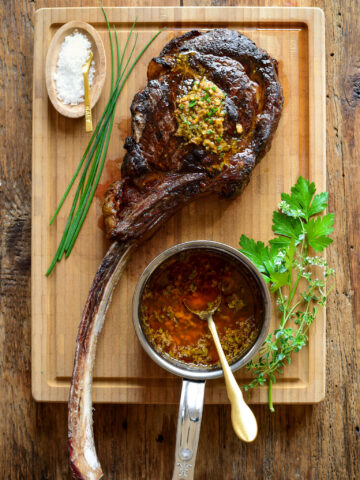
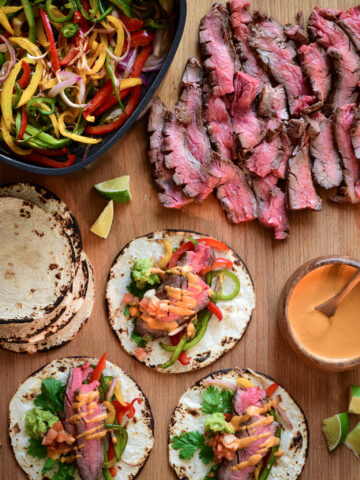
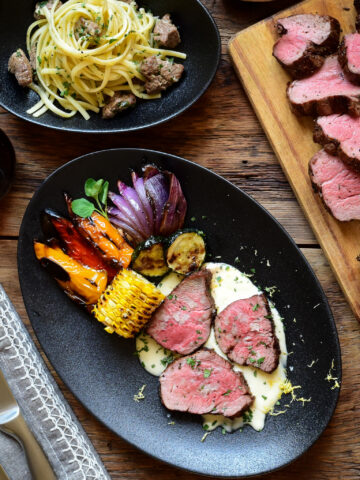

Leave a Reply